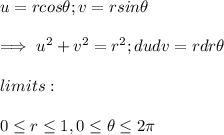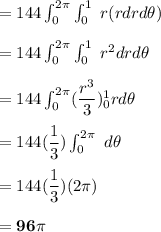Answer:
96π
Explanation:
The transformation x = au , y = bv (a>0, b>0) can be re-written as;
 which maps the circular region u² + v² ≤ 1 into the elliptical region
which maps the circular region u² + v² ≤ 1 into the elliptical region

Integrating and transforming the elliptical region into a circular region;

here;
R = region enclosed by the ellipse.

Let x = 3u ; y = 4v
Jocobian = J(x,y)
![= \left[\begin{array}{ccc}(\partial x)/(\partial u)&(\partial x)/(\partial v)\\(\partial y)/(\partial u)&(\partial y)/(\partial v)\\\end{array}\right] \\ \\ \\ \\ = \left[\begin{array}{ccc}3&0\\0&4\\\end{array}\right] \\ \\ \\ = 12](https://img.qammunity.org/2022/formulas/mathematics/college/il3m80hmu9yzjn3vmwoyyjtesbey44wkw0.png)
So;

Using polar coordinates;

∴

